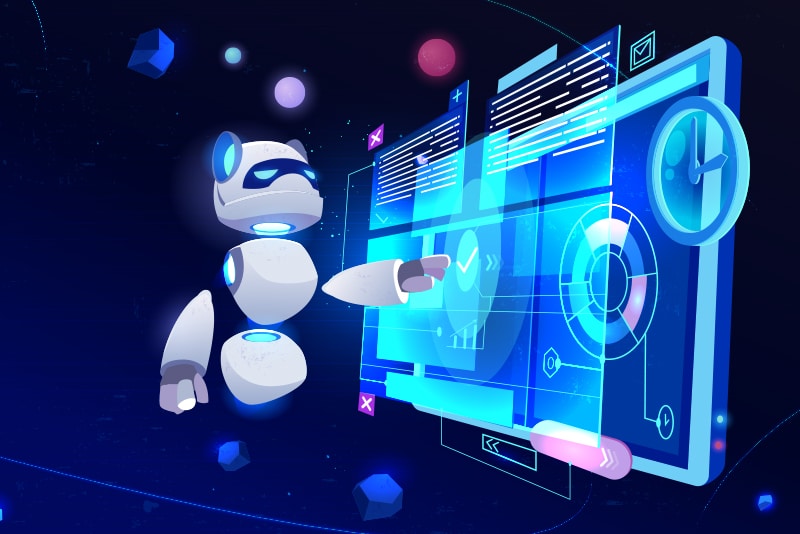With several technological advancements, the compliance landscape is becoming extremely complex. The constant changes in the regulatory environment, a lack of understanding of compliance measures and limited technology capabilities are some of the primary reasons why companies are looking for strong compliance solutions. Furthermore, meeting regulatory compliances is costly, labor-intensive, and error-prone when done manually. An automation-first strategy or the use of robotic process automation technology can ensure companies are meeting compliance needs while also saving time and reducing costs. Robotic process automation (RPA) helps organizations to better navigate the complexities of achieving and maintaining compliance in the rapidly evolving regulatory landscape. Key technology applications like artificial intelligence (AI) and machine learning incorporated by a robotic process automation company can help automate and streamline business operations and deliver a better customer experience.
What Is Robotic Process Automation (RPA)?
In simple terms, RPA (Robotic Process Automation) is a software technology that allows you to automate digital operations. The technology enables software users to develop software robots, or “bots,” that can learn, mimic, and then execute business operations based on rules. Users can construct bots using RPA automation by monitoring human digital actions. RPA software bots can interact with any specific application or system in the same manner that humans perform, except for the fact that RPA bots can work around the clock, much faster, with 100 percent accuracy and precision. Given the demands of modern corporate compliance, embracing these innovative technologies can help organizations maintain their compliance programs, and create long-term sustainability and scalability.
What Is Compliance? What Are the Key Business Areas Where Automation Can Help?
In simple terms, compliance involves adhering to laws, policies, and regulations to protect data integrity, data security, and employee and customer privacy. In fact, different departments and industries have different compliance challenges. Governmental mandates and internal corporate policies are the two most common types of compliance. Here are some examples of two common governmental compliances by industry/business areas –
- Healthcare – Government compliance acts protect patient privacy by allowing healthcare organizations to safeguard patient information. In healthcare, scheduling, billing, remote care, record management, document digitization and data entry are critical areas for automation.
- Insurance and financial services – The federal Gramm-Leach-Bliley Act (GLBA) governs how financial institutions and their related firms protect the personal information of their customers. Quote to cash, procure to pay, and record to report are all areas where finance can be automated.
- Banking – Equal Credit Opportunity (ECO) bans lenders from discriminating against credit applicants, establishes procedures for collecting and assessing credit information, and mandates written notice when credit is rejected. Bank reconciliation, customer onboarding, trade finance, report production and application processing are some of the crucial areas for automation in this area.
- Human Resources (HR) – Anti-discriminatory compliances prohibit employers in all industries from taking negative employment actions based on race, color, sex, ethnic origin, disability, or age. Key areas where automation can help include the tracking and updating of employee information, onboarding, performance management, and payroll.
How RPA Helps in Compliance – Key Benefits
Automation allows business organizations from diverse industries to achieve world class compliance. Business organizations can use RPA technology to develop robust and top-tier compliance procedures. It offers a new degree of control, allowing businesses to track and control their internal business operations. These logs may be checked and monitored at any time, allowing companies to address any compliance issues that occur quickly. Here are some key benefits of RPA in compliance for business organizations –
- Better Compliance Management – Installing RPA technology can help improve several areas of compliance operations. For instance, the capacity of RPA to retrieve and aggregate data from many sources can help improve regulatory reporting efficiency by reducing the total time spent on collecting, synthesizing, and summarizing huge amounts of data. RPA also makes it easy to map policies related to corporate procedures, rules and processes while ensuring that automation activity is compliant.
- Increased Productivity – Compliance teams need to run a series of separate tests to see if their operations conform to specific rules, laws, and regulations and modify internal policies as needed. As each business firm needs to carry out a wide range of tests, planning, document/evidence gathering, test execution, and reporting are required for each test. RPA implementation in such cases can enhance employee engagement by automating repetitive and manual tasks like monitoring and testing. Therefore, the employee tasks can be refocused on certain other things like quality assurance and judgment-based monitoring and testing.
- Increase in Auditability – As an audit can occur at any time in a bank, keeping track of staff activity is crucial. However, this monitoring can suffer due to human error, and companies may not get accurate results. RPA technology can save all their actions in an activity log. This provides companies with an audit trail that properly displays which procedures were completed and how, and when exceptions were produced, and how employees intervened to resolve the difficulties. Moreover, RPA helps in cost reduction, quality improvement, and improved employee satisfaction. By automating compliance, organizations can eliminate legal concerns and avoid litigation and monetary fines. Organizations can also incorporate internal safeguards that improve day-to-day operations by guaranteeing compliance and complying with legal responsibilities. RPA also helps firms create a safe working environment by improving customer and employee retention.
- Greater Oversight – Instead of outsourcing, RPA automation tools allow businesses to take more control over their operations and keep them under one roof as RPA software bots’ actions can be saved, logged, reviewed, and monitored at any time.
- Data Precision – Automated data extraction from multiple sources and formatting helps increase speed and efficiency, reducing the chance of data errors.
- Automatically Update Regulation Requirements – According to a KPMG survey, 60 percent of organization leaders reported that they do not use automation to stay up-to-date on regulation details, which are frequently modified by policy makers. RPA bots can scrape policy makers’ websites, extract news about regulations, and update regulation data in the organization’s internal regulation databases.
Automation can speed up business processes, free employees from tedious manual processes and allow them to focus on handling complex tasks. RPA increases the efficiency and accuracy of compliance, freeing businesses from the worry of noncompliance consequences. The importance of meeting the ever-changing compliance requirements will continue to be a driving force for organizations to automate. Though RPA offers several benefits, it can never replace human interactions. To ensure the accuracy of business processes and data, organizations can rely on the services of professional business process outsourcing companies.




